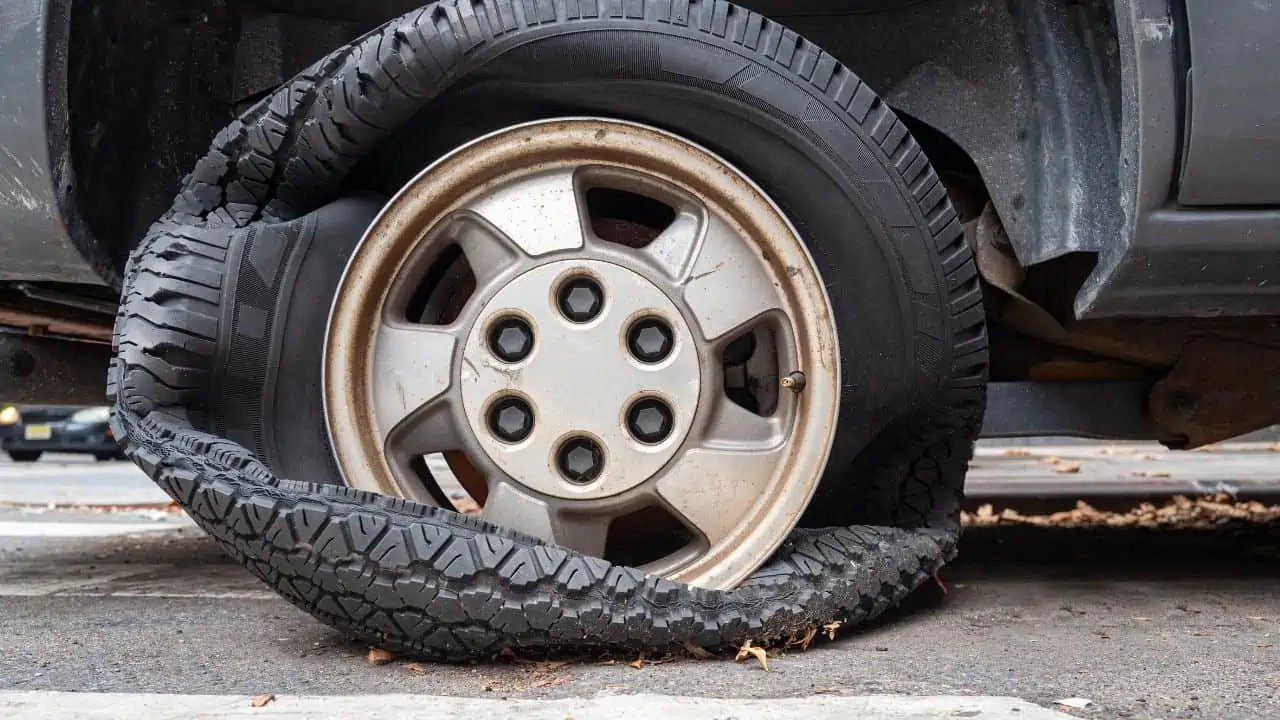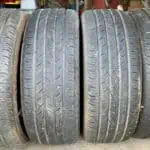Yes, a patched tire can blow out. Although patching a tire can extend its life, it is not a permanent fix. Over time, the patch will slowly lose its adhesive properties and come loose.
Once the patch comes loose, it will no longer be able to hold air in the tire, causing it to deflate and eventually blow out.
Few things are as scary on the open road as a tire blowout. When one occurs, it can feel like you’ve lost all control of your vehicle. Unfortunately, blowouts are fairly common, especially if you don’t properly maintain your tires.
One question we often get here at our auto shop is whether or not a patched tire is more likely to experience a blowout than one that hasn’t been repaired. The answer isn’t always cut and dry, but we thought we’d give you some food for thought on the matter. Generally speaking, a patched tire is no more likely to experience a blowout than an unpatched one.
However, there are a few factors that could make patching your tire riskier. First, if the puncture was large or located in the sidewall of the tire, it’s possible that the patch didn’t adhere properly. In these cases, it’s worth getting your tire checked out by a professional before hitting the road again.
Second, even if the patch is applied correctly, repeated air loss can cause problems down the line. If you notice that your patched tire is losing air more quickly than usual, bring it in so we can take a look. It’s possible that there’s another issue at play and addressing it right away will save you from a potentially dangerous situation later on.
Can a Patched Tire Blowout?
Is It Safe to Drive With a Patched Tire?
It is safe to drive with a patched tire as long as the patch is properly applied and the tire is not significantly damaged. If the patch is not applied correctly or the tire is severely damaged, it can cause a blowout.
Can a Patched Tire Explode?
No, a patched tire cannot explode. While a tire can blow out, this is not the same as an explosion. A blowout occurs when the pressure inside the tire becomes too great and causes the tire to rupture.
An explosion requires a detonation of some sort, which would not occur in a tire patching scenario.
How Long Can You Ride on a Patched Tire?
If you’ve got a flat tire, you’re probably wondering how long you can ride on a patched tire. The answer is: it depends. Here are a few things to consider that will affect how long your patched tire will last:
1. The size of the patch. A small patch will likely wear out more quickly than a large one.
2. The location of the patch. A patch on the tread of the tire will wear down faster than one on the sidewall.
3. The type of terrain you’re riding on. Smooth pavement is easier on tires than on rough roads or trails.
4. Your riding style. If you’re an aggressive rider who likes to push your bike to its limits, your tires will wear out more quickly than if you’re a leisurely rider who takes it easy on the pedals.
Do Patched Tires Lose Air?
It’s a common question: do patched tires lose air? The answer, unfortunately, is not a simple one. It depends on several factors, including the size and location of the patch, the type of tire, and how well the patch was applied.
Generally speaking, however, most patches will hold up well and won’t cause your tire to lose air. If you have a small puncture in your tire, for example, a patch can be an effective way to seal it up so that air doesn’t escape.
There are some situations where patched tires may lose air more quickly than others.
If the puncture is large or if it’s located in the sidewall of the tire, for instance, then there’s a greater chance that air will leak out around the patch. Additionally, if the adhesive used to apply the patch isn’t strong enough or if it wasn’t applied correctly in the first place, then that can also lead to problems down the road.
That way you can catch any potential leaks before they become too big of a problem.
Can I Drive Long Distance With a Patched Tire
It’s generally not a good idea to drive long distances with a patched tire. While a patch can temporarily fix a puncture, it’s not a permanent solution. over time, the patch can come to lose or break, which could lead to another flat tire.
If you have to drive long distances with a patched tire, be sure to check the pressure regularly and stop every few hours to inspect the tire for any signs of trouble.
How Long Can You Drive on a Patched Tire
It’s common for drivers to experience a flat tire at some point. When this happens, you may be tempted to simply patch the hole and continue driving. But how long can you drive on a patched tire?
There are a few factors that will affect how long your patched tire will last. First, the size of the hole is important. A small puncture can often be safely repaired, while a large gash will likely require a new tire.
Next, the location of the hole is crucial. If it’s in the tread area, your tire can probably be safely patched. However, if the hole is in the sidewall, it’s best to replace the tire entirely.
Sidewall damage weakens tires and makes them more susceptible to blowouts. Finally, the quality of your repair job matters. If you do it yourself with a kit from the auto parts store, it probably won’t hold up as well as a professional repair from a qualified technician.
In general, though, patches can last anywhere from a few days to several months or even years. It depends on how big and severe the damage is and how well-repaired it is. So if you have a flat tire, don’t hesitate to get it fixed – whether that means patching it or replacing it entirely.
How Fast Can You Drive on a Patched Tire?
If you’ve ever had a flat tire, you know the feeling of dread that comes with it. Not only do you have to deal with the hassle of changing your tire, but you also have to worry about driving on a patched tire. So how fast can you drive on a patched tire?
The answer depends on the severity of the patch and where it is located on the tire. A small patch in the tread area may not impact your speed much, but a large patch or one that is located near the sidewall can severely limit your speed. In general, it’s best to avoid driving over 50 mph on a patched tire.
Of course, if you find yourself in an emergency, you may have to push your limits. But even then, it’s important to go as slow as possible and be extra careful when driving on a patched tire. Remember, safety always comes first!
Is It Safe to Drive on a Patched Tire
It’s no secret that patched tires are not as safe as new ones. In fact, according to a recent study, patched tires are three times more likely to fail than new tires. The reason for this is that patches can weaken the structure of the tire, making it more susceptible to blowouts and other failures.
So, should you avoid driving on patched tires? Not necessarily. If you have a flat tire and need to get to your destination, a patch may be your best option.
Just be sure to drive carefully and keep an eye on your tire pressure. And, of course, if you have any doubts about the safety of your tire, it’s always best to err on the side of caution and replace it with a new one.
Patched Tire Vs New Tire
When it comes to your tires, you want to make sure they’re in good condition. But what happens when you get a flat? Should you patch it up or get a new tire?
There are pros and cons to both options. Patching a tire is usually cheaper than buying a new one, but it may not last as long. A new tire will cost more, but it will likely last longer.
So, which is the right choice for you? It depends on your situation. If you can’t afford a new tire right now or if the damage isn’t too bad, patching it up may be the way to go.
But if the damage is significant or you’re due for new tires anyway, getting a new one may be the better option.
How Long Does a Patched Tire Last
If you’ve ever had a flat tire, you know the feeling of relief when you get it patched up. But how long does that patch job last? The answer may surprise you.
According to the Rubber Manufacturer’s Association, a properly repaired tire can last indefinitely. That’s right – with proper care and maintenance, your patched tire could last as long as your car does. Of course, there are a few caveats to this claim.
First, the patch must be done correctly for it to hold up over time. Second, even the best patch job won’t last forever if you don’t take care of your tires. Regular rotation and balance are key to prolonging the life of any tire, patched or not.
So if you’ve got a flat, don’t despair – just get it fixed and then take good care of your tires! With a little TLC, your patched tire could be with you for the long haul.
Patched Tire Losing Air
If you’ve ever driven on a flat tire, you know it’s not fun. Not only is it uncomfortable, but it’s also dangerous. Driving on a flat tire can damage the tire and the wheel, and can even lead to an accident.
So what do you do if you have a flat tire? The first thing is to not panic. If you can safely pull over to the side of the road, do so.
Once you’re safe, you’ll need to change the tire. But before you do, it’s important to check the other tires to make sure they’re properly inflated. If one of your tires is low on air, there may be a leak in the tire.
To find out, put your hand over the valve stem and see if the air is coming out. If there’s a leak, you’ll need to patch or replace the tire. If there’s no leak, then inflating the tire should take care of the problem.
Just be sure to check the pressure regularly from now on so that you can catch any leaks before they become big problems!
Conclusion
A patched tire can blow out if it is not done correctly. If the patch is not big enough, then the pressure from the tire can cause it to blow out. Also, if the patch is not applied correctly, then it can come off and cause a blowout.










